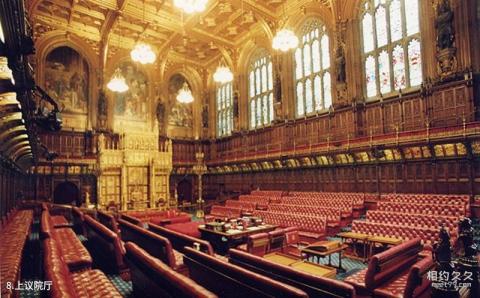
Introduction to the House of Lords Hall: The House of Lords Hall is located on the south side of the Palace of Westminster. The room is 13.7m × 24.4 meters in rectangular shape. The interior is luxuriously decorated. It is similar to other parts of the building. The seats in this hall are also red. The upper four walls of the hall are decorated with stained glass and six murals that reflect religious, chivalrous and legal meanings.
The south end of the hall is a golden throne and canopy. For a long time, the king or queen only attended the opening ceremony of the parliament. Other royal members would sit next to the throne when they attended the meeting. The chair of the Speaker of the House of Lords in front of the throne is a backless, filled-in seat. A red soft seat full of wool. The Speaker's seat of the House of Lords is used to preside over meetings in the hall. The scepter symbolizing the royal authority is placed behind the Speaker's seat. In front of the Speaker's seat is the arbitration seat, a slightly larger red soft seat, which is used for the opening ceremony of the Parliament. The seats for the Law Lords and the square table in the atrium are the seats for the record clerks. Members of the House of Lords attended the meeting on red benches on three sides of the hall. On the right side of the speaker are the clergy seats and on the left side are the secular seats: clergy members (archbishops and bishops of the Church of England) sit in the clergy seats, and secular nobles (nobles) sit on the clergy seats. Parties sit: the ruling party sits on the side close to the clergy, the opposition party sits on the secular seats, and some non-partisan nobles sit opposite the speaker's seat in the middle. They are the so-called "crossbench members."
The Chamber of the House of Lords is the venue for many important ceremonies, the most important of which is the opening of Parliament before Parliament convenes each year. The Queen will issue a Royal Proclamation from the throne, outlining the legislative agenda for the subsequent Parliament. Members of the House of Commons will not enter the debate floor of the House of Lords. Instead, they will watch the entire process from the seats on the upper floor of the House of Lords. The same ceremony is performed at the close of Parliament, but the Queen is not necessarily present; it is often attended by representatives of the Monarchy's Council.
